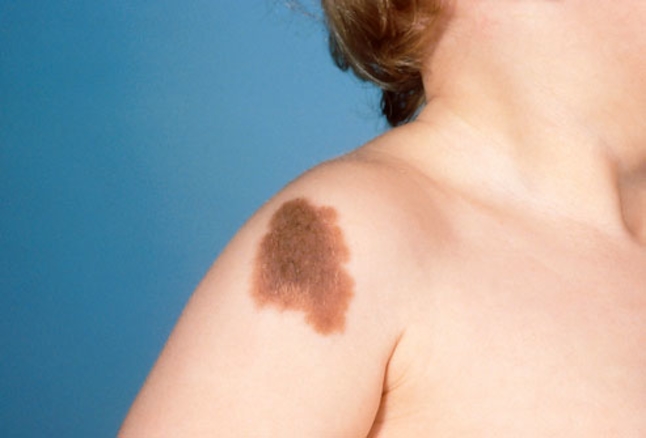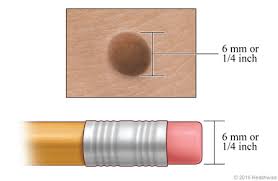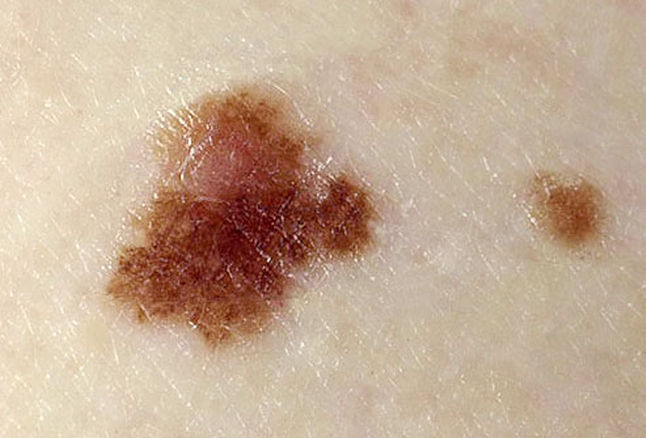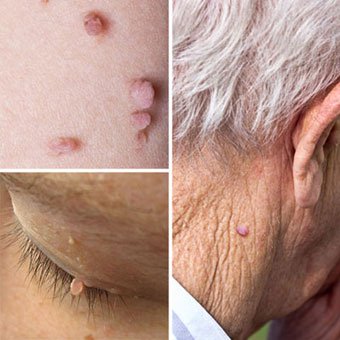Learn more about the blemishes that are on your skin! Is there such a thing as cancerous skin tags? Is it precancerous? It is a harmless blemish? What kind of growth is this? First let’s learn a little bit about the kind of growths that appear on our skin. Moles…freckles…skin tags! These skin lesions are very common and are benign. Benign is a fancy word for non cancerous.
Moles appear at a young age…they first start appearing at childhood and during the first 15-20 years of one’s life. Over time, the mole could change in color, perhaps grow hairs, or it may not change at all. Moles occur when cells called melanocytes grow in a cluster instead of spread out throughout the skin. These cells also give moles the pigment that they have, but over time a mole could darken due to exposure to the sun and a few other factors.
There are two types of moles:
- Congenital nevi
- Dysplastic nevi
Congenital Nevi
Congenital nevi moles are present at birth. About 1 in 100 are born with a congenital nevi mole. These types of moles are more prone to developing into melanoma.

 If the mole or freckle on your skin has a diameter of larger than a pencil eraser- go get it checked out by a physician or dermatologist. These birthmarks do have a slight increased risk of becoming cancer so it is always best to have larger congenital nevi moles checked out.
If the mole or freckle on your skin has a diameter of larger than a pencil eraser- go get it checked out by a physician or dermatologist. These birthmarks do have a slight increased risk of becoming cancer so it is always best to have larger congenital nevi moles checked out.
Be aware if the mole has changed in size at all – any changes should be reported to your dermatologist or physician. All congenital nevi moles – big or small – should be checked out by your dermatologist or physician. If the dermatologist believes they need to review the mole further they will by do so.
The second mole mentioned is dysplastic nevi.
Dysplastic Nevi
Dysplastic nevi are moles that are not the rounded shape but instead are pretty odd shaped. They are pretty irregular in shape actually and they are much larger than a pencil eraser.

They often have various brown colors – dark and light, and uneven coloration. The dysplastic nevi moles are more likely to become a melanoma. WebMd states the fact of: “people who have 10 or more dysplastic nevi (moles) have a 12 times higher chance of developing melanoma, a serious form of skin cancer.” Dysplastic nevi moles should be looked at by a medical provider. Also any changes to the mole should be told to your dermatologist as well. Now that we’ve learned about moles…How do we tell if the mole is cancer or not?
Now just because we have a mole does not mean that the mole is cancer. The vast majority of moles found on the body are harmless. The moles that we should be on the lookout for and could be cancer forming are those that change in size or shape over time. Also, moles that have appeared after the age of around 25. If you notice that moles on your skin have changed in sizes, shape, or have become increasingly sensitive, painful, or bleed, it is best to consult a dermatologist right away. Just because you’re not a kid anymore doesn’t mean you don’t need to know your ABCDE’s…
..
The ABCDE of Skin & Mole Review:
With this tool under your belt, you’ll be able to spot any traces of melanoma right at home. Early detection is key, its up to us to take charge!
![]()
- Asymmetry. If sectioned in 2 parts, one part of the mole does not match the other half.
- Border. The edges surrounding the mole of the mole or border are jagged or irregular.
- Color. The color of the mole is not the same throughout or has shades of tan, brown, black, blue, white, or red.
- Diameter. The diameter of a mole is larger than the eraser of a pencil (about 6mm)
- Evolution. The mole is changing in size, shape, or color.
Earlier we dropped the word, Melanoma. Melanoma is a type of skin cancer.
There are a few other types of skin cancer:
- Melanoma
- Basal Cell
- Squamous Cell
The two most common are basal cell and squamous cell. The treatments for these types of skin cancer can be very effective. However, malignant melanoma can be much harder to treat. Of course with anything, early detection is key to increase survival rate when dealing with skin cancer.
Moving on to skin tags…

Skin tags are non cancerous. They may be unsightly, but they are harmless. A skin tag is a small flap of skin colored tissue that hangs off the body by another piece of tissue or a stalk. A skin tag differs from a mole because a mole does not hang off the skin as a skin tag does. Skin tag will not cause you any physical pain unless snagged by jewelry or thread from clothing. A cancerous mole may cause pain – especially melanomas. If you notice any bleeding, pain, or irregularities from your mole, it is important you see a dermatologist right away.
It may not be necessary to remove the skin tag. They do no harm if left alone to live out it life like your little companion.There are some skin tag at home removal treatments that are pretty easy to try and you can do from the convenience of your own home…
This is not medical advice. Always consult with your doctor when considering diagnosis and treatments.
==> 13 At Home Safe Skin Tag Removal Treatments That Will Surprise You!

